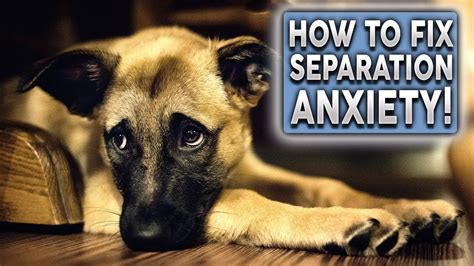Are you struggling with your dog’s separation anxiety? You’re not alone. Many pet owners face the challenges of helping their furry friends cope with being left alone. In this comprehensive guide, we’ll cover everything you need to know about preventing separation anxiety in dogs. From understanding the root causes of this common issue to recognizing the signs in your pet, we’ll walk you through the steps to creating a secure and comfortable environment for your dog. You’ll also learn the importance of establishing a consistent routine, as well as how to gradually desensitize and countercondition your dog to being alone. Additionally, we’ll discuss the benefits of introducing interactive toys and puzzles, implementing positive reinforcement techniques, and when to seek professional help and support. By the end of this post, you’ll be equipped with the knowledge and tools to help your dog overcome separation anxiety and lead a happy, healthy life.
Understanding Separation Anxiety in Dogs
Separation anxiety in dogs is a common behavioral issue that many pet owners may face. It refers to the distress and anxiety experienced by a dog when it is separated from its owner or left alone. This can result in destructive behaviors, excessive barking, or even self-harm as the dog tries to cope with its anxiety.
It is important for dog owners to recognize the signs of separation anxiety in their pets. These signs can include pacing, excessive salivation, and attempts to escape from the home when left alone. Understanding these signs can help pet owners address the issue and provide the appropriate support and care for their dogs.
Creating a secure and comfortable environment for the dog is crucial in managing separation anxiety. This can involve providing a safe space for the dog, such as a crate or a designated area in the home, where the dog feels secure and relaxed. Additionally, using calming pheromone products or playing soothing music can help create a calming atmosphere for the dog when left alone.
Establishing a consistent routine can also help in managing separation anxiety in dogs. Dogs thrive on routine and structure, so having set times for feeding, exercise, and alone time can help the dog feel more secure and less anxious when left alone. Consistency and predictability can provide a sense of stability for the dog and reduce its anxiety levels.
Recognizing Signs of Separation Anxiety
Separation anxiety in dogs is a common behavioral issue that can be distressing for both the pet and their owner. It is important to be able to recognize the signs of separation anxiety in order to address the issue effectively. Recognizing the signs is the first step towards helping your dog feel more secure and comfortable when left alone.
One of the most common signs of separation anxiety in dogs is excessive barking, whining, or howling when they are left alone. This vocalization is often a sign that the dog is feeling distressed and anxious about being separated from their owner.
Another sign to recognize is destructive behavior, such as chewing furniture, scratching doors, or digging. Dogs with separation anxiety may exhibit this behavior as a way to alleviate their stress and anxiety while their owner is away.
Changes in eating or bathroom habits can also be indicative of separation anxiety. Some dogs may refuse to eat or drink when left alone, while others may have accidents in the house despite being house trained.
Creating a Secure and Comfortable Environment
One of the most important steps in helping a dog with separation anxiety is to create a secure and comfortable environment for them. This can help to reduce their stress and anxiety when you are away from home. To do this, make sure your dog has a designated safe space, such as a comfortable bed or crate, where they can retreat to when they are feeling anxious. It’s important that this space is located in a quiet area of your home, away from any loud noises or distractions.
Additionally, you can help to create a more secure environment for your dog by providing them with something that has your scent on it, such as an old t-shirt or blanket. This can help to comfort your dog and make them feel more at ease when you are not at home. Another way to create a secure and comfortable environment for your dog is to make sure they have access to plenty of toys and enrichment activities to keep them occupied while you are away.
It’s also important to ensure that your dog has access to the bathroom and fresh water while you are away, as this can help to reduce any anxiety related to physical discomfort. Providing your dog with all of the necessities they need in your absence can go a long way in creating a more secure and comfortable environment for them.
Finally, it’s important to make sure that your dog is getting enough exercise and mental stimulation on a daily basis. This can help to reduce their overall stress levels and make them more resilient to anxiety when you are not at home. Taking your dog for regular walks, engaging in playtime, and providing them with interactive toys and puzzles can all contribute to creating a secure and comfortable environment for your dog.
Establishing a Consistent Routine
Establishing a consistent routine is essential for helping dogs overcome separation anxiety. Dogs thrive on predictability and structure, so having a set schedule can help alleviate their anxiety when left alone.
Start by setting regular times for feeding, walks, and playtime. This will help your dog know what to expect and when, creating a sense of security and stability.
Additionally, try to keep departures and arrivals as low-key as possible. By downplaying your comings and goings, you can help reduce your dog’s anxiety around separations.
Consistency is key when establishing a routine. Stick to the same schedule every day, as even small deviations can cause stress and uncertainty for your dog.
Gradual Desensitization and Counterconditioning
Gradual desensitization and counterconditioning are two powerful tools in helping dogs overcome separation anxiety. Desensitization involves gradually exposing your dog to the triggers of their anxiety in a controlled and safe environment. This helps them learn to tolerate being alone and reduces their fear response. This process must be done slowly and systematically to be effective.
Counterconditioning, on the other hand, involves changing your dog’s emotional response to being alone. This is achieved by pairing the experience of being alone with something positive, such as a special treat or toy. Over time, your dog will start to associate being alone with a positive experience, reducing their anxiety.
When implementing gradual desensitization and counterconditioning, it’s important to be patient and consistent. Rushing the process can actually make your dog’s anxiety worse. It’s also crucial to seek guidance from a professional dog trainer or behaviorist, as they can provide personalized support and guidance based on your dog’s specific needs.
By implementing these techniques, you can help your dog learn to be more comfortable and confident when left alone, ultimately improving their overall well-being and quality of life.
Introducing Interactive Toys and Puzzles
Introducing interactive toys and puzzles can be a great way to help alleviate separation anxiety in dogs. Interactive toys and puzzles can provide mental stimulation and keep your dog entertained while you’re away, helping to reduce their stress and anxiety. These toys can also help redirect your dog’s focus from your absence to an enjoyable activity, helping them to feel more secure and comfortable.
When introducing interactive toys and puzzles to your dog, it’s important to choose ones that are safe and suitable for their size and breed. Look for toys that are durable and can withstand your dog’s chewing and play. Puzzle toys that dispense treats or require problem-solving can be particularly effective in keeping your dog engaged and distracted from their anxiety.
It’s also important to gradually introduce interactive toys and puzzles to your dog. Start by offering the toy during times when you’re still at home, so your dog can associate it with positive experiences. Once they show interest and enjoyment in the toy, you can begin incorporating it into your departure routine, providing it as a form of mental stimulation while you’re away.
Overall, interactive toys and puzzles can be a valuable tool in helping your dog cope with separation anxiety. By providing mental stimulation, distraction, and a sense of enjoyment, these toys can play a significant role in creating a secure and comfortable environment for your dog, even when you’re not there.
Implementing Positive Reinforcement Techniques
Positive reinforcement is an effective and humane way to address behavioral issues in dogs. It involves rewarding desired behaviors with treats, praise, or affection to encourage repetition of those behaviors. One of the key aspects of implementing positive reinforcement techniques is timing. It is important to reward the desired behavior immediately to create a strong association between the behavior and the reward.
Consistency is also crucial when using positive reinforcement. Dogs thrive on routine and predictability, so it’s important to consistently reward the desired behavior every time it occurs. This helps the dog understand what is expected of them and increases the likelihood of the behavior being repeated.
It’s important to use high-value rewards when implementing positive reinforcement techniques. This could be a favorite treat, a special toy, or extra attention. The reward should be something that motivates the dog and makes them enthusiastic about earning it.
Lastly, when implementing positive reinforcement techniques, it’s essential to avoid punishment or negative reinforcement. Instead of focusing on what the dog is doing wrong, the emphasis should be on rewarding what they are doing right. This creates a positive learning environment and strengthens the bond between the dog and their owner.
Seeking Professional Help and Support
When it comes to dealing with separation anxiety in dogs, it can be a challenging and overwhelming experience. If you find that your furry friend is struggling with extreme distress when you’re not around, seeking professional help and support is crucial.
Many pet parents may feel lost and hopeless when trying to address their dog’s separation anxiety on their own. This is where seeking the expertise of a professional comes into play. A trained dog behaviorist or veterinarian can provide valuable insights and guidance on how to manage and alleviate your dog’s separation anxiety.
Professional help may involve behavior modification techniques, medication, or a combination of both, depending on the severity of your dog’s separation anxiety. It’s important to recognize that each dog is unique, and what works for one may not work for another. This is where professional help can make a significant difference in understanding and addressing your dog’s specific needs.
Remember, seeking professional help does not mean that you have failed as a pet parent. It simply means that you are proactive and committed to providing the best possible care for your four-legged companion. With the right support and guidance, you can work towards helping your dog overcome separation anxiety and lead a happier, more balanced life.





